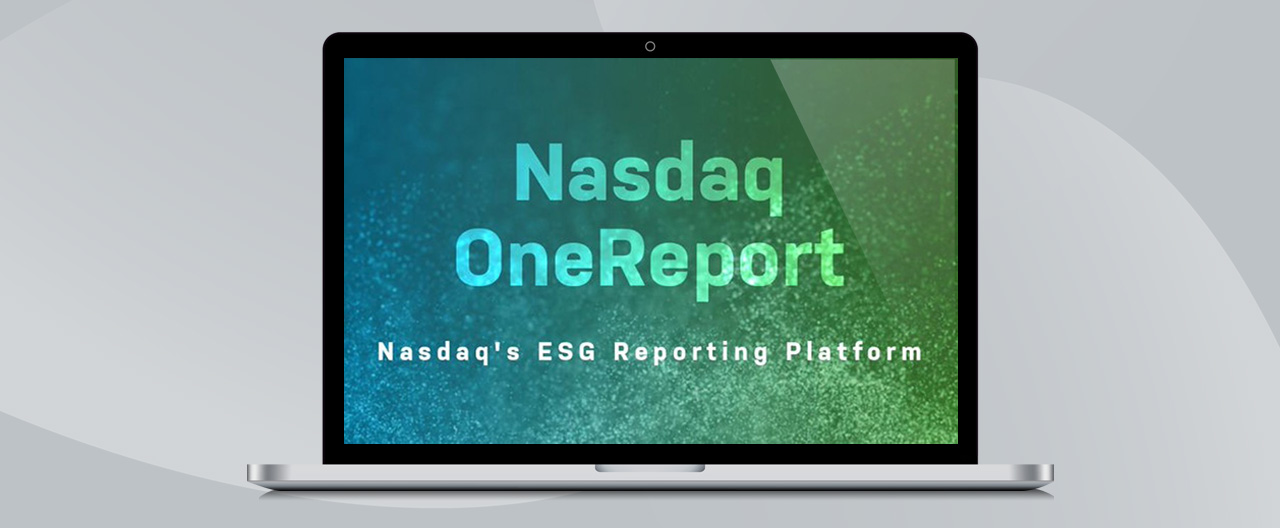According to Nasdaq’s 2020 survey of 30 institutional investors representing $17 trillion in equity under management (over $35 trillion in assets under management), ESG Engagement: State of the Market, investors are becoming more engaged in Environmental, Social and Governance (ESG) as they prefer public disclosure of ESG data due to increased investment dollars flowing towards ESG activities.
These activities include reducing carbon footprints, providing safe and healthy workplaces, and having diverse leadership teams and boards. Stakeholders are making it increasingly clear they expect companies to take a proactive approach to ESG policies and messaging.
To discuss the latest trends around ESG, including corporate communications and ESG reporting, Notified’s Sylvie Harton, SVP and Global Head of PR and IR Solutions, sat down with Nasdaq’s Randall Hopkins, VP and Head of ESG SaaS Solutions and Regional Head of Capital markets, at NIRI 2022 for an engaging conversation about the future of ESG communications.
Watch the video highlights of their conversation and read the full transcript below.
Full Transcript of ESG Communications and Stakeholder Engagement Interview
Sylvie Harton:
There really is a trend around stakeholder engagement. The question becomes really communicating about ESG, as we mentioned, an important component of shareholder engagement and a way to attract more capital. In that context, would you be able to speak to examples of companies incorporating ESG that have done it well?
Randall Hopkins:
Some of the most compelling examples are folks that have engaged with the raters or the rankers or the frameworks to help attract new sources of investor capital or for that matter, engagement with their employees or members of their supply chain to really drive value for their enterprise. And I think a good example is we work with a company recently that hadn't engaged with one of the rating organizations historically, their first time out was 2021, and they were able to make a brand-new index for the first time by using just these disclosure strategies.
They were able to be included in the index. And it was a great kind of access to capital because it wasn't highly expensive for them to engage or sell to the investors. They were actually included in the index and got a lot of passive money that came in chasing the index and as a result became a top-20 shareholder for the company because of their choices to get involved in the industry disclosure.
Sylvie:
It's interesting because it also demonstrates some thought leadership, right? A good way to do it, in that respect. That's really interesting. A public company wants to send a consistent message to their stakeholders. Do you have advice on how to do it using their earnings calls, their IR website and all of the reports around ESG?
Randall:
I think good companies are seeing integrated reporting as a way to be not just consistent throughout the year, but also to reinforce the message. Part of it is consistency from a risk management perspective. They don't want to have a different number or a different statement in a shareholder presentation or from a request for proposal (RFP) response.
But beyond that, I think we recognize from a marketing and a communication perspective, it takes several iterations. You know, there's a number, maybe it's four, maybe five, maybe six times that a person needs to hear a message before it really sinks in. And, from a marketing perspective, we've always learned that from an academic perspective.
This is an opportunity for companies to not just be consistent, but also to be able to get that message to resonate and to land for their stakeholders. And I think that's the opportunity we all see to help tell that story and get that narrative to land for our stakeholders.
Sylvie:
Well, speaking about, ESG messaging resonating, what are your thoughts with respect to using video, for example, to communicate that story?
Randall:
I think that's a really important and a great question. I think that the ESG story for many companies is a very personal story and a very intimate story and a very foundational story for a company. Why do we exist? What are we here for? What is our calling, our purpose? And I think that, video is an especially important tool to be able to get that gravity understood by the recipient.
We all have the written word, but video media is very compelling, it's very personal. And to that extent, I think that it's well-suited for an ESG purpose message because you can really understand the meaning and the impact that is given for the deliverer of the message and hopefully for the recipient as well.
Sylvie:
As long as that message obviously is delivered with intensity and, ingenuousness.
Randall:
I think that's fascinating. And I think that, we have to assume that it's authentic and genuine at the company level. But I think if you can have that and also bring the video component, I think you're increasing your chances of success tenfold.
Sylvie:
It's interesting because this trend around humanizing your communication on ESG using video has a little bit of overlap with the rise of retail investors. So how would you recommend a publicly traded company tell their ESG story in the context of rising retail investors?
Randall:
It's an interesting trend, of course, because we see a lot of both good and bad observed by public companies. Not all public companies cherish retail participation. Not all companies are built the same. But I think what is true is that if you have a good message that can be delivered to the retail audience, you certainly know that the votes can be more favorable, that you can have more resonance if you're in a consumer goods environment, you get to have more sales as a result and I think it's an important way to get that message.
Again, speaking about consistency, it gets it lined up with all your stakeholders and with some of the technologies we were talking about, video, some of the technologies, now we can address some of the friction that companies might have had in addressing retail. Before It was a very expensive, dubious return on investment. If we're looking 10 years back, it took a special company to want to engage with the retail investor audience.
Now, technologies being what they are, we can do it at cost, at scale, and have better engagement with those stakeholders as well.
Sylvie:
What are the downsides of not communicating or not understanding your ESG story and communicating it to your shareholders?
Randall:
I think on the margin cost of capital, and in these uncertain times, that can be for some companies a real existential challenge if you don't have cost of capital within bounds then you could be facing the prospect of not being in business next year.
I think it's less draconian than that. You could just miss the opportunity to have better outcomes with your employees for example. Much has been made, but perhaps not enough, about the fact that engagement with employees is so important and these times where attracting and retaining talent is for most companies the one, recognizable driver for success. I think the downside would be losing more employees, having talent leave the doors, go to a competitor, or just go and retire.
We see the great resignation and its impact on our businesses, and I think doing well from an ESG communication perspective at least minimizes the risk.
Sylvie:
Isn't it also the expectation in the current conference that clients are expecting?
Randall:
I think at the end of the day it's really interesting to observe how many clients are making decisions based on how they might learn about companies' posture toward their employees and the ecosystem in which they operate. That could be their philanthropic activities, that could be how they have treated ex-employees or maybe other members of the community that they operate within.
So I think there's an awful lot of connective tissue on these things, and I think it really does drive a lot of value for a company to be thinking all the way through these stories.
Sylvie:
What about storytelling? There are a lot of investor relations teams that are actually included - or not.
Randall:
It's a great question. We probably find as many different answers to that question as we ask at the times that we ask. It does take a village. Investor relations certainly has a seat at the table oftentimes, along with marketing professionals and public affairs.
We'll also see the corporate control or we'll see general counsel, a chief risk officer, even HR. Rarely, sometimes you'll even see the CEO get right in there to really own that message or set the tone and be part of the process for the entire way. And so it's one of the things that's really exciting about it because in a way, you could say, well, does ESG deserve its own term or are we really just talking about business?
Sylvie:
That's right.
Randall:
Are we just talking about good business here? Because maybe we don't need the term, we just say, what is it? What is it to be a good company? What is it to bedriving value to all in our stakeholder network and if we call it ESG or we don't call it ESG, maybe that is just a matter of let's all get involved. Let's all sit around the table and make good businesses for those in our stakeholder network.
Sylvie:
That's really interesting because it's a good segway to what you think the future of ESG will be, especially in the context of it is actually in business. It's good business to be sustainable. So how do you think ESG will evolve over time?
Randall:
I think it's a really challenging question because there's so many vectors, right? We can think about how data works. Like, a lot of the work that we do is around helping companies collect and manage the data that they're going to ultimately disclose. I think that world is fast evolving, right? That will be moving more and more toward good governance around our environmental posture, good governance, around our social posture.
And so I think the evolution will certainly be a data-driven one. We need to manage what we can. And as we go through the measurement process, we need to make sure that we have good assessment. I think the other thing that we observe is that when we get around to evolving our businesses toward broader stakeholder networks, we have to recognize that they may not all align.
Sylvie:
Yeah.
Randall:
And we may need to make some hard decisions around who we are, who do we want to be, how do we think about driving ultimate value for that stakeholder network. And I think that will be the future of all of our businesses as we think to 2030 and 2040, where will we be? How will we think about driving that over time?
Sylvie:
Well, it was absolute pleasure, Randall. We are so excited for this partnership. We spent a fair amount of time evaluating solutions in the market and we are absolutely confident that Nasdaq OneReport is the right one and I think that will create a lot of value for our joint customers. Thank you again.
Randall:
Thanks so much, Sylvie. It's great to be here and thanks so much for the partnership.
The IRO's Guide to Stakeholder Engagement
Learn how to tell a consistent and cohesive story across digital channels.



